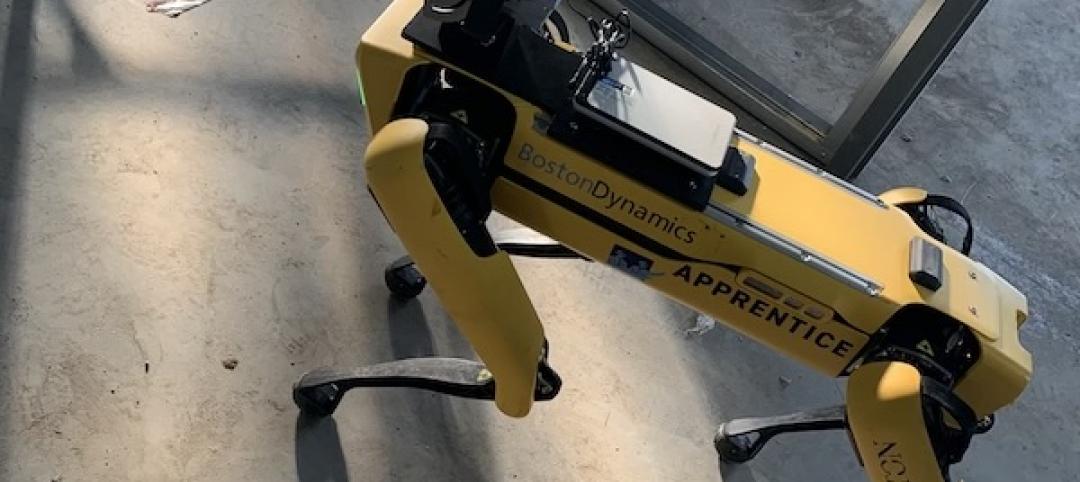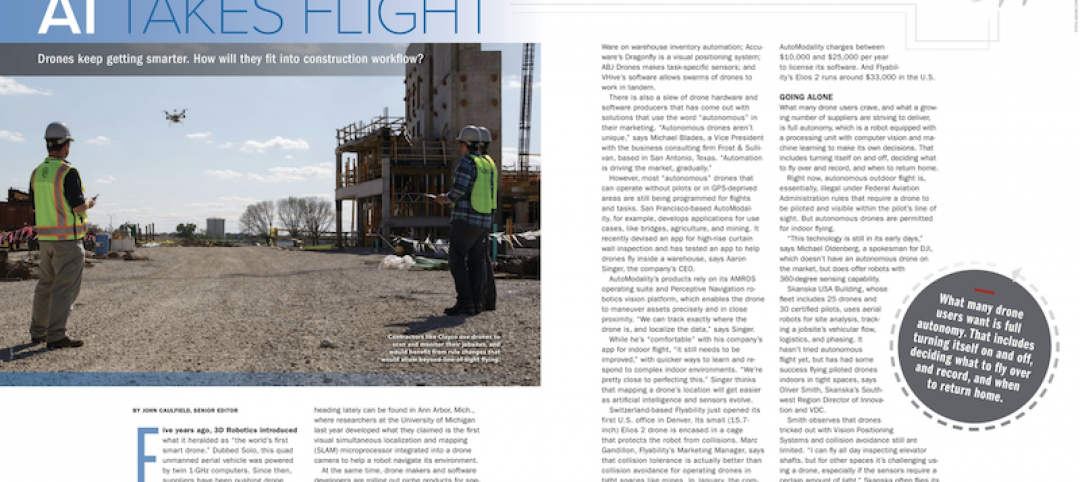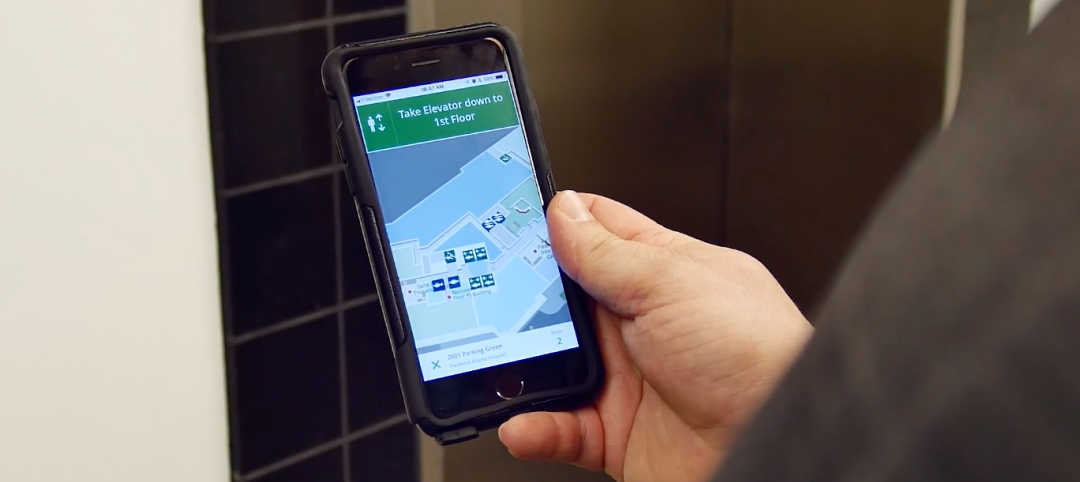Last year, in a tech report on artificial intelligence (AI), BD+C reported that Arup had applied a “neural network” to a light rail design and reduced the number of utility clashes by over 90%, saving nearly 800 hours of engineering.
The same report described an algorithm developed by workspace-sharing giant WeWork that is 40% more accurate than humans at predicting meeting room usage. The article proposed that machine learning is “still a theoretical proposition” for most of the AEC industry, even though the practical results of these examples suggest that AI has bridged the gap from theory to practice.
In fact, the consensus in our industry seems to be that AI’s limitations will always hold it back. In 2015, WeWork’s then Director of Research, Daniel Davis, declared that “it is—for now—impossible to get computers to think creatively, manage multidisciplinary teams, and do many of the other day-to-day tasks.” Citing University of Oxford research estimating that there’s a less than 2% chance that architects’ jobs will be automated, Davis concludes that architecture cannot be automated at all. (The statistics stickler in me wants to point out that 2% is not zero.)
As long ago as 2012, Wired’s Kevin Kelly insisted otherwise, predicting that automation in every industry was “just a matter of time.” “It doesn’t matter if you are a doctor, lawyer, architect, reporter, or even programmer. The robot takeover will be epic,” wrote Kelly.
ALSO SEE: 4 fundamental relationships between buildings and machines
And despite Davis’ claim that computers cannot “think creatively,” others forecast the opposite—that computers in fact will be responsible for the “coming creativity explosion.”
The underlying question here is simply this: Are machines capable of design? To answer that, we’d have to clarify the meaning of design, a surprisingly elusive term. One dictionary defines it as “an arrangement of lines or shapes created to form a pattern or decoration.”
Computer programs have been capable of automating this process since the early ’60s. Later that decade, in The Sciences of the Artificial (1969), Nobel economist Herbert Simon famously defined design as “devising courses of action aimed at changing existing situations into preferred ones.”
The examples from Arup and WeWork certainly demonstrate how to create “preferred situations.” Today, whole businesses are being founded around AI-driven design. Using a proprietary algorithm, California-based Cover can develop custom house plans within a few hours.
Nevertheless, many are skeptical. “I am convinced,” says innovation expert Nick Seneca Jankel, “that no computer, no matter how powerful, will ever be able to purposefully innovate an artistic breakthrough like hip hop, or a commercial one like Instagram. Breakthrough creativity is fundamentally organic, not algorithmic.”
Yet, this point of view suggests that computer processes will always be defined as they are now and will remain incapable of becoming “organic, not algorithmic.” Google’s Ray Kurzweil is certain that machines will achieve human-level intelligence in a decade and significantly outpace us thereafter. How can we possibly envision the capability of computers once they have exponentially exceeded our awareness?
So, instead of debating about whether machines can design, why don’t we ask, What if they could? How might architecture change if computers take over the process entirely?
Already, machine-driven procedures can dramatically improve the efficiency of design, construction, and operations—for example, by increasing energy performance and decreasing fabrication time and costs. Yet, often architects get in the way of these improvements because we insert our personal aesthetic preferences.
How much smarter could buildings get if we let them design themselves for optimal performance? A growing wealth of research is revealing how people respond to light, space, form, pattern, texture, and color, and much of this information could be automated during design. “Beauty is merely a function of mathematical distances or ratios,” explains computer scientist Daniel Cohen-Or, who invented a “beauty engine” that subtly improves photos—with an 80% success rate, according to polling.
So, if architects were to step out of the way and allow architecture to evolve beyond our imaginings, what kind of world might emerge? Louis Kahn famously asked, “What does the building want to be?” If Kurzweil is correct, and buildings achieve self-awareness soon, they could become what they want to be without asking us. Self-actualized architecture.
For now, the likelihood of architects letting go of their traditional services seems low. A BD+C reader survey in January revealed that 81% of designers believe that computers will never match human intelligence, and only half said that job losses would be justified if AI could create better buildings. This begs a big question: What do we value more—architects or architecture?
Lance Hosey, FAIA, LEED Fellow, is a Design Director with Gensler. His book, The Shape of Green: Aesthetics, Ecology, and Design, has been an Amazon #1 bestseller in the Sustainability & Green Design category.
Related Stories
AEC Tech | Oct 23, 2020
Risk mitigation: Seeing the forest and the tree
This case study highlights how new data analysis tools can be successfully leveraged to gain insights into some of the more abstract aspects of building evaluations.
Architects | Oct 14, 2020
The Weekly Show: AI for building facade inspections; designing a world-class architecture firm
The October 15 episode of BD+C's "The Weekly" is available for viewing on demand.
Smart Buildings | Oct 1, 2020
Smart buildings stand on good data
The coming disruption of owning and operating a building and how to stay ahead through BIM.
Digital Twin | Aug 27, 2020
The Weekly show: Digital twin technology and social equity in the AEC market
The August 27 episode of BD+C's "The Weekly" is available for viewing on demand.
AEC Tech | Apr 13, 2020
A robotic dog becomes part of Swinerton’s construction technology arsenal
Boston Dynamics, the robot’s creator, has about 100 machines in the field currently.
AEC Tech | Mar 30, 2020
Will 3D printing be an answer for building more affordable homes?
A project in southern California will put onsite fabrication to the test against other construction modes.
AEC Tech | Mar 23, 2020
Working from home? Don't miss out on the latest issue of Building Design+Construction
BD+C's March issue features the largest and most important technological innovations across the AEC industry.
AEC Tech | Mar 17, 2020
A tree grows in Stanford: CIFE, VDC, and where it all began
As our industry adopts VDC as standard practice, it is important to remember where these ideas began and continue to emanate from today.
AEC Tech | Mar 10, 2020
No labor. No infrastructure. No problem.
OpenSpace’s AI-based reality capture tool looks to make site documentation a completely passive experience.
Healthcare Facilities | Mar 9, 2020
Mobile wayfinding platform helps patients, visitors navigate convoluted health campuses
Gozio Health uses a robot to roam hospital campuses to capture data and create detailed maps of the building spaces and campus.















